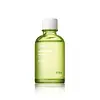What's inside
What's inside
 Key Ingredients
Key Ingredients

 Benefits
Benefits

 Concerns
Concerns

No concerns
 Ingredients Side-by-side
Ingredients Side-by-side

Water
Skin ConditioningHouttuynia Cordata Extract
Skin ConditioningMethylpropanediol
SolventCentella Asiatica Extract
CleansingPanthenol
Skin ConditioningSodium PCA
HumectantDiospyros Kaki Leaf Extract
Skin ProtectingVitis Vinifera Fruit Extract
Skin ConditioningCoffea Arabica Seed Extract
MaskingCarthamus Tinctorius Flower Extract
Skin ConditioningPolygonum Cuspidatum Root Extract
AntioxidantCamellia Sinensis Leaf Extract
AntimicrobialCastanea Crenata Shell Extract
Skin ConditioningZanthoxylum Piperitum Fruit Extract
Skin ConditioningSodium Hyaluronate
HumectantCynanchum Atratum Extract
Skin ConditioningLavandula Angustifolia Extract
Skin ConditioningRosmarinus Officinalis Extract
AntimicrobialOriganum Vulgare Flower/Leaf/Stem Extract
Skin ConditioningThymus Vulgaris Extract
PerfumingHydroxyacetophenone
AntioxidantButylene Glycol
HumectantAllantoin
Skin ConditioningEthylhexylglycerin
Skin ConditioningSodium Phytate
Citric Acid
BufferingWater, Houttuynia Cordata Extract, Methylpropanediol, Centella Asiatica Extract, Panthenol, Sodium PCA, Diospyros Kaki Leaf Extract, Vitis Vinifera Fruit Extract, Coffea Arabica Seed Extract, Carthamus Tinctorius Flower Extract, Polygonum Cuspidatum Root Extract, Camellia Sinensis Leaf Extract, Castanea Crenata Shell Extract, Zanthoxylum Piperitum Fruit Extract, Sodium Hyaluronate, Cynanchum Atratum Extract, Lavandula Angustifolia Extract, Rosmarinus Officinalis Extract, Origanum Vulgare Flower/Leaf/Stem Extract, Thymus Vulgaris Extract, Hydroxyacetophenone, Butylene Glycol, Allantoin, Ethylhexylglycerin, Sodium Phytate, Citric Acid
Water
Skin ConditioningPropanediol
SolventGlycerin
HumectantMethylpropanediol
SolventCentella Asiatica Extract
CleansingHydrolyzed Glycosaminoglycans
HumectantSodium Hyaluronate Crosspolymer
HumectantHydrolyzed Hyaluronic Acid
HumectantRaspberry Ketone
MaskingHydroxypropyltrimonium Hyaluronate
Sodium Acetylated Hyaluronate
HumectantSodium Hyaluronate
HumectantEthylhexylglycerin
Skin ConditioningHyaluronic Acid
HumectantMadecassoside
AntioxidantAsiaticoside
AntioxidantAloe Barbadensis Leaf Juice Powder
Skin ConditioningBenzyl Glycol
SolventErythritol
HumectantHydroxyethylcellulose
Emulsion StabilisingBiosaccharide Gum-1
HumectantDipotassium Glycyrrhizate
HumectantPolyglucuronic Acid
Skin ConditioningButylene Glycol
HumectantDipropylene Glycol
HumectantCaprylyl Glycol
EmollientPanthenol
Skin ConditioningAllantoin
Skin ConditioningPantolactone
HumectantXanthan Gum
Emulsifying1,2-Hexanediol
Skin ConditioningHydroxyacetophenone
AntioxidantDisodium EDTA
Water, Propanediol, Glycerin, Methylpropanediol, Centella Asiatica Extract, Hydrolyzed Glycosaminoglycans, Sodium Hyaluronate Crosspolymer, Hydrolyzed Hyaluronic Acid, Raspberry Ketone, Hydroxypropyltrimonium Hyaluronate, Sodium Acetylated Hyaluronate, Sodium Hyaluronate, Ethylhexylglycerin, Hyaluronic Acid, Madecassoside, Asiaticoside, Aloe Barbadensis Leaf Juice Powder, Benzyl Glycol, Erythritol, Hydroxyethylcellulose, Biosaccharide Gum-1, Dipotassium Glycyrrhizate, Polyglucuronic Acid, Butylene Glycol, Dipropylene Glycol, Caprylyl Glycol, Panthenol, Allantoin, Pantolactone, Xanthan Gum, 1,2-Hexanediol, Hydroxyacetophenone, Disodium EDTA
Ingredients Explained
These ingredients are found in both products.
Ingredients higher up in an ingredient list are typically present in a larger amount.
Allantoin is a soothing ingredient known for its protective and moisturizingg properties. Because of this, it is often added to products with strong active ingredients.
Studies show higher concentrations of this ingredient can promote wound healing.
Though it can be derived from the comfrey plant, allantoin is produced synthetically for cosmetic products to ensure purity.
Learn more about AllantoinButylene Glycol (or BG) is used within cosmetic products for a few different reasons:
Overall, Butylene Glycol is a safe and well-rounded ingredient that works well with other ingredients.
Though this ingredient works well with most skin types, some people with sensitive skin may experience a reaction such as allergic rashes, closed comedones, or itchiness.
Learn more about Butylene GlycolCentella Asiatica Extract (Centella) is derived from an herb native to Southeast Asia. It is famous for its anti-inflammatory and soothing properties.
Centella is rich in antioxidants and amino acids, such as Madecassic Acid and Asiaticoside.
Studies show the compounds in centella help with:
The combination of all these properties makes centella effective at soothing, hydrating, and protecting the skin.
Other great components of centella include Vitamin A, vitamin C, several B vitamins, and Asiatic Acid.
Fun fact: Centella has been used as a medicine and in food for many centuries. As a medicine, it is used to treat burns, scratches, and wounds.
Learn more about Centella Asiatica ExtractEthylhexylglycerin (we can't pronounce this either) is commonly used as a preservative and skin softener. It is derived from glyceryl.
You might see Ethylhexylglycerin often paired with other preservatives such as phenoxyethanol. Ethylhexylglycerin has been found to increase the effectiveness of these other preservatives.
Hydroxyacetophenone is antioxidant with skin conditioning and soothing properties. It also boosts the efficiency of preservatives.
This ingredient is not irritating or sensitizing.
Methylpropanediol is a synthetic solvent and humectant.
As a solvent, it helps dissolve other ingredients, helping to evenly distribute ingredients throughout the product. This ingredient has also been shown to have antimicrobial properties which makes it a preservative booster.
Methylpropanediol is able to add a bit of moisture to the skin. It also helps other ingredients be better absorbed into the skin, such as salicylic acid.
Learn more about MethylpropanediolPanthenol is a common ingredient that helps hydrate and soothe the skin. It is found naturally in our skin and hair.
There are two forms of panthenol: D and L.
D-panthenol is also known as dexpanthenol. Most cosmetics use dexpanthenol or a mixture of D and L-panthenol.
Panthenol is famous due to its ability to go deeper into the skin's layers. Using this ingredient has numerous pros (and no cons):
Like hyaluronic acid, panthenol is a humectant. Humectants are able to bind and hold large amounts of water to keep skin hydrated.
This ingredient works well for wound healing. It works by increasing tissue in the wound and helps close open wounds.
Once oxidized, panthenol converts to pantothenic acid. Panthothenic acid is found in all living cells.
This ingredient is also referred to as pro-vitamin B5.
Learn more about PanthenolSodium Hyaluronate is hyaluronic acid's salt form. It is commonly derived from the sodium salt of hyaluronic acid.
Like hyaluronic acid, it is great at holding water and acts as a humectant. This makes it a great skin hydrating ingredient.
Sodium Hyaluronate is naturally occurring in our bodies and is mostly found in eye fluid and joints.
These are some other common types of Hyaluronic Acid:
Learn more about Sodium HyaluronateWater. It's the most common cosmetic ingredient of all. You'll usually see it at the top of ingredient lists, meaning that it makes up the largest part of the product.
So why is it so popular? Water most often acts as a solvent - this means that it helps dissolve other ingredients into the formulation.
You'll also recognize water as that liquid we all need to stay alive. If you see this, drink a glass of water. Stay hydrated!
Learn more about Water